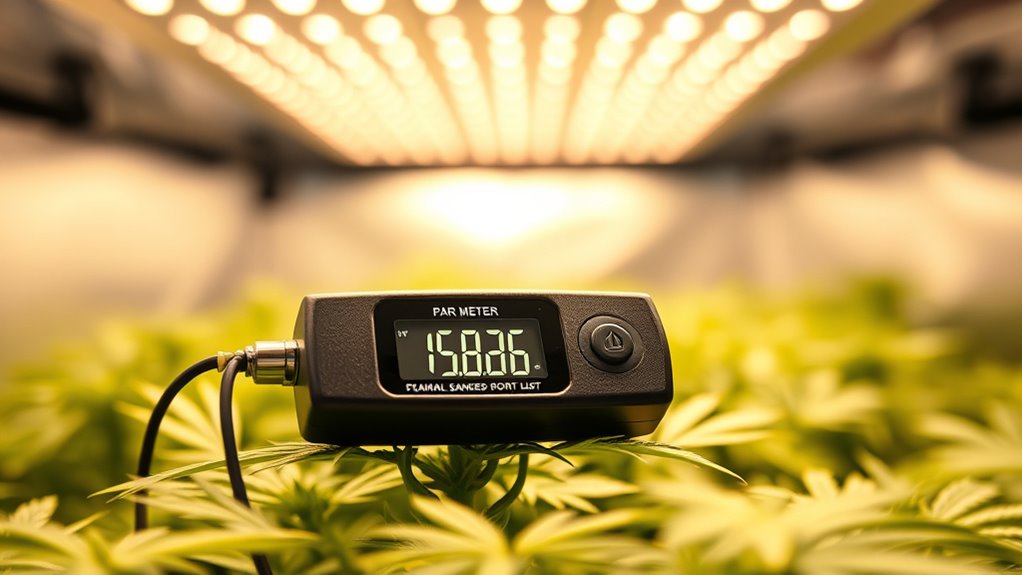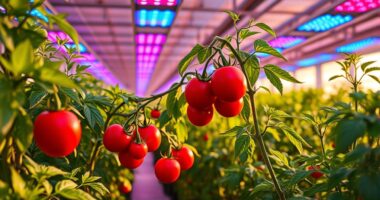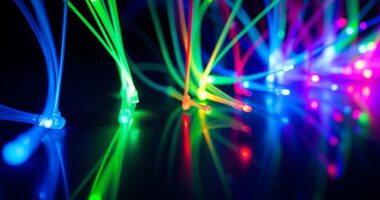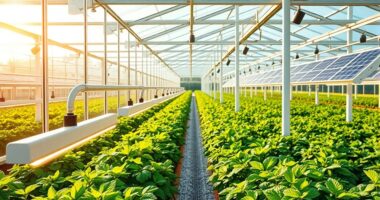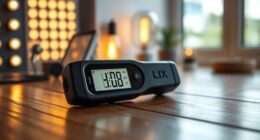Looking for the best PAR meters for your grow lights in 2025? I’ve researched top models that offer accurate light measurement, spectrum analysis, and ease of use, including compact designs, Bluetooth connectivity, and precise PPFD readings. Whether you’re a hobbyist or professional, these tools help optimize your setup for maximum plant health. Keep going, and I’ll share detailed insights on choosing the perfect meter to fit your needs.
Key Takeaways
- Evaluate meters with high accuracy (±1-3 μmol/m²/sec) and broad measurement ranges (up to 3999 μmol/m²/sec) for precise grow light assessments.
- Prioritize devices with spectral measurement capabilities, including UVA, IR, and separate red/blue readings, for comprehensive light analysis.
- Choose models with data logging, Bluetooth/app integration, and easy calibration options to streamline measurement and analysis processes.
- Opt for ergonomic, portable designs with large displays, remote sensors, and tripod compatibility for flexible indoor and outdoor use.
- Consider user-friendly interfaces and compatibility with various grow light types (LED, HPS, DE) for versatile, professional-grade light management.
VBR-100 Quantum PAR Meter for Light Spectrum Measurement
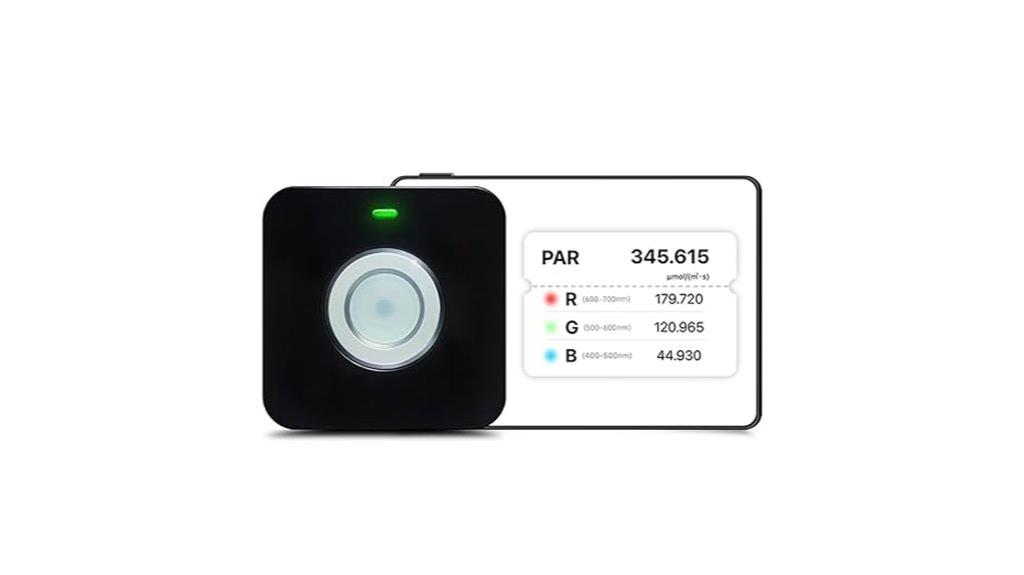
If you’re serious about optimizing your grow lights, the VBR-100 Quantum PAR Meter is a top choice because it provides precise measurement of PAR and PPFD across the full spectrum, including separate readings for red and blue light. I appreciate its ability to measure these key wavelengths since blue light enhances photosynthesis, and red light supports flowering. The device calculates DLI if PPFD remains stable, giving me accurate data for plant health. It also records PPFD across different points, helping me ensure uniform light distribution. Its portability and easy Bluetooth connectivity make on-the-go testing simple, making it a reliable tool for any serious grower.
Best For: serious growers and horticulturists seeking precise, full-spectrum light measurement to optimize plant growth and energy efficiency.
Pros:
- Provides accurate PAR and PPFD measurements across the full spectrum, including separate red and blue light readings
- Enables calculation of DLI under stable conditions for detailed light exposure analysis
- Portable and easy to connect via Bluetooth, facilitating on-the-go testing in greenhouses or with drone-mounted setups
Cons:
- May require familiarity with light measurement concepts for optimal use
- Limited details on pricing and compatibility with other lighting systems
- Dependence on Bluetooth connection could pose issues in environments with interference
Quantum PAR Meter Full-Spectrum Photosynthetic Light Lux Tester
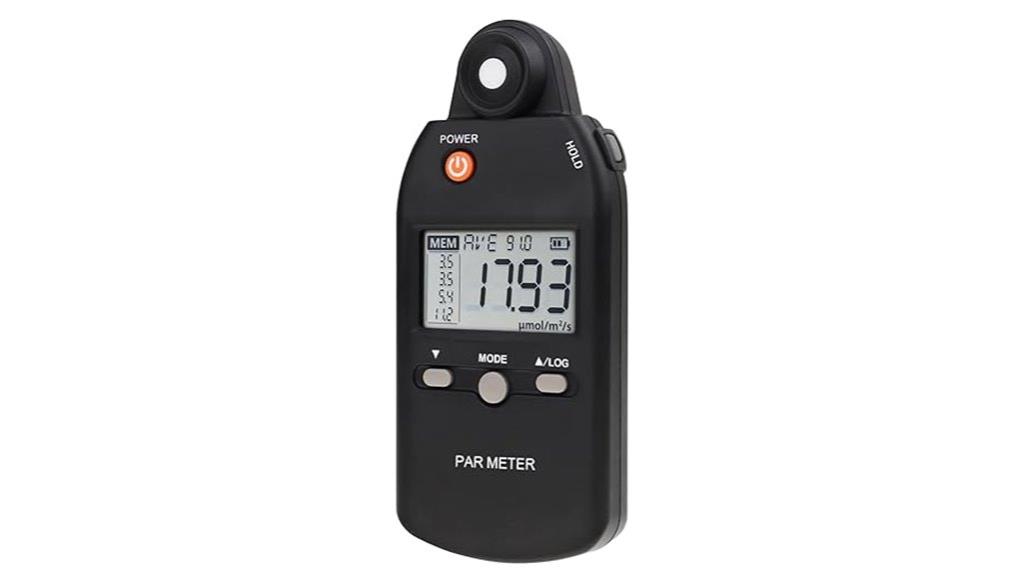
The Quantum PAR Meter Full-Spectrum Photosynthetic Light Lux Tester stands out for its precise measurement capabilities, making it ideal for growers, scientists, and researchers who need reliable data on light conditions. It measures PAR from 0 to 5000 μmol/m²/sec within a 400-700 nm waveband, ensuring accurate readings for photosynthesis. The device stores up to 100 measurements and displays the last four readings for quick review. Its compact, lightweight design makes it portable and easy to use in greenhouses or fields. With a tripod socket for stability and an ergonomic interface, this meter supports detailed monitoring, helping optimize plant growth and energy efficiency.
Best For: growers, scientists, and researchers seeking accurate, reliable measurements of photosynthetic light conditions to optimize plant growth and energy efficiency.
Pros:
- Precise measurement range of 0 to 5000 μmol/m²/sec within the critical 400-700 nm waveband.
- Stores up to 100 measurements and displays the last four readings for efficient tracking.
- Compact, lightweight, and portable design with tripod socket for stable, flexible testing.
Cons:
- Tripod not included, requiring an additional purchase for stable mounting.
- Limited to measurements within the 400-700 nm waveband, not covering broader spectral analysis.
- Requires manual data management and interpretation, potentially needing supplementary analysis tools.
AH-Quantuv PAR Meter for Grow Light, PPFD and UVA Irradiance Measurement

For growers seeking precise measurements of light quality and intensity, the AH-Quantuv PAR Meter stands out as an excellent choice. It measures PAR from 400-750nm and UVA irradiance from 320-400nm, providing detailed data on red, green, and blue light components. Its high-quality Japanese sensor guarantees accuracy comparable to professional meters costing around $500. The device features functions like HOLD, PAR distribution mapping, and logs up to 100 data points, making it user-friendly. Compact and lightweight, it’s perfect for indoor and outdoor use, helping growers optimize light spectrum, intensity, and plant development stages with confidence.
Best For: indoor and outdoor growers, horticulturists, and plant enthusiasts seeking precise, comprehensive light measurement to optimize plant growth conditions.
Pros:
- High accuracy with a Japanese sensor comparable to professional meters costing around $500
- Measures both PAR and UVA irradiance, providing detailed spectrum data for plant health
- User-friendly features like HOLD, data logging, and PAR distribution mapping for easy analysis
Cons:
- Lacks internal calibration verification, requiring periodic calibration checks for optimal accuracy
- Front display positioning may be less visible in bright outdoor conditions, although the HOLD function mitigates this
- Does not include advanced spectral measurements like far-red, limiting some specific research applications
Quantum PAR Meter for LED Grow Light
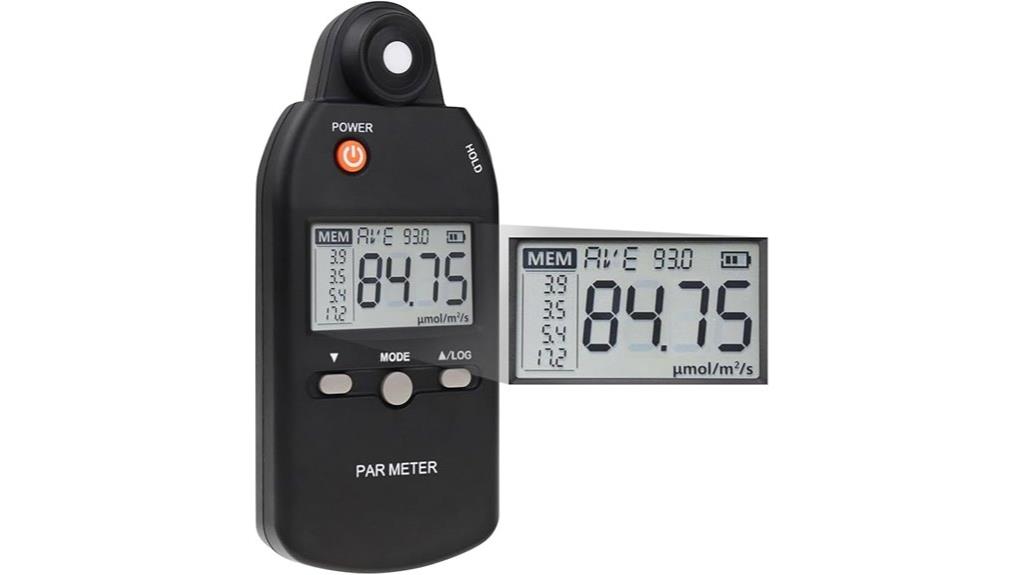
Given its precise measurement capabilities and user-friendly design, the Quantum PAR Meter for LED Grow Light is an excellent choice for indoor gardeners and horticulturists seeking accurate light data. It measures Photosynthetic Photon Flux Density (PPFD) from 0 to 5000 μmol/m²/sec within the key spectrum for plant growth. Its large display makes readings easy to see, and it offers MAX, MIN, and AVG functions for detailed analysis. Compact and lightweight, it’s simple to handle during regular monitoring. Powered by just two AAA batteries, this model ensures consistent, reliable measurements, helping you optimize your grow light setup for healthier, more productive plants.
Best For: indoor gardeners, horticulturists, and plant researchers seeking precise, easy-to-read light measurement to optimize plant growth.
Pros:
- Accurate measurement of Photosynthetic Photon Flux Density (PPFD) from 0 to 5000 μmol/m²/sec within the key spectrum for plant growth.
- Large, easy-to-read display with MAX, MIN, and AVG data functions for detailed analysis.
- Compact, lightweight design powered by only two AAA batteries, ideal for regular monitoring and portability.
Cons:
- Limited measurement range up to 5000 μmol/m²/sec may not suit extremely high-intensity lighting setups.
- Internal storage capacity of 100 data points might require manual data management for extensive testing.
- Battery-powered operation may require periodic replacement for continuous use.
Full Spectrum PAR Meter for PPFD, UVA, Blue and IR Measurements

A full spectrum PAR meter is essential for growers who want precise insights into their lighting conditions, especially since it measures PPFD across 400-750nm and includes irradiance power within 320-400nm. It displays separate PAR values for blue and red light, helping me understand how different spectrum components affect plant growth. The UVA measurement and logging features allow me to analyze UVA radiation’s influence on morphology and stress resistance, while the hold function makes reading easier. By providing detailed data on blue, red, UVA, and IR light, this meter helps optimize light setups, ensuring healthier plants and better yields.
Best For: growers and horticulturists seeking precise measurement and analysis of light spectrum components, including PPFD, UVA, blue, and IR light, to optimize plant health and yields.
Pros:
- Provides comprehensive full spectrum PAR measurement including UVA and IR, offering detailed insight into light conditions.
- Displays separate PAR values for blue and red light, helping tailor lighting for specific plant growth stages.
- Features logging and hold functions that facilitate thorough analysis and easy reading of test results.
Cons:
- May require calibration for accurate measurements across all spectrum ranges.
- The device’s complexity could be overwhelming for casual or beginner growers.
- Limited information on battery life and durability for extended outdoor or commercial use.
PAR Meter for LED Grow Lights
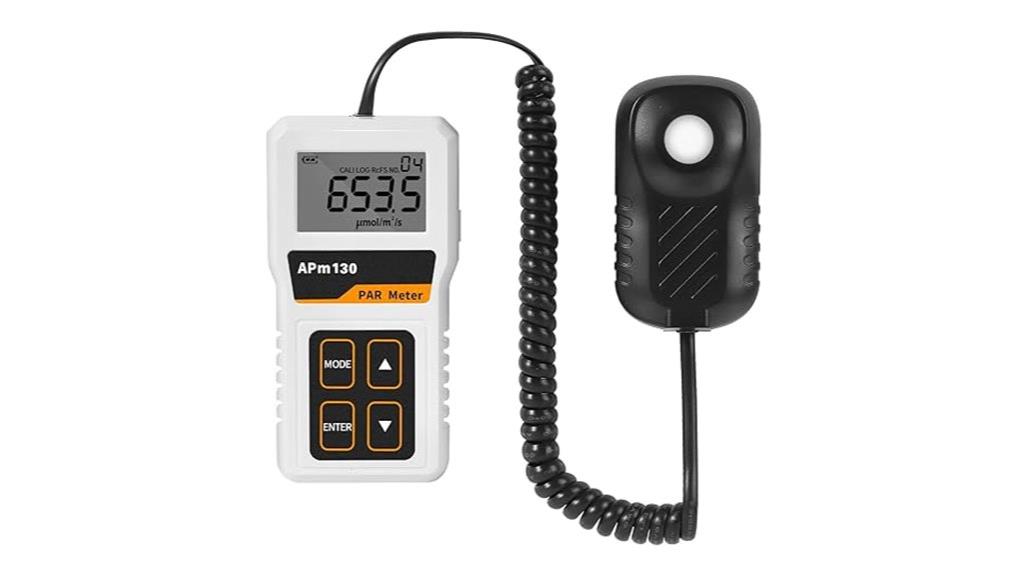
The PAR Meter for LED Grow Lights stands out with its high-precision split design, making it ideal for indoor growers, researchers, and greenhouse operators who demand accurate, real-time PPFD measurements. It measures light within the 400-700nm range, providing instant readings up to 4,000 µmol/m²s. Its portability and lightweight build make it easy to use across different locations, with a remote sensor and versatile cables for measuring distant points. The device stores up to 99 measurements, helping you track light variations over time. It’s perfect for ensuring uniform light distribution, optimizing LED performance, and supporting research or production needs with reliable data.
Best For: indoor growers, researchers, and greenhouse operators seeking precise, real-time PPFD measurements for optimal plant growth and light management.
Pros:
- High precision split design for accurate measurements within 400-700nm range
- Portable and lightweight, easy to use across multiple locations
- Stores up to 99 measurements for tracking light variations over time
Cons:
- Requires connection to remote sensor, which may be cumbersome in tight spaces
- Limited to measuring PPFD within 400-700nm spectrum only
- Battery life and maintenance details are not specified, potentially affecting long-term use
LGBQM2 Advanced Quantum Sensor PAR Meter
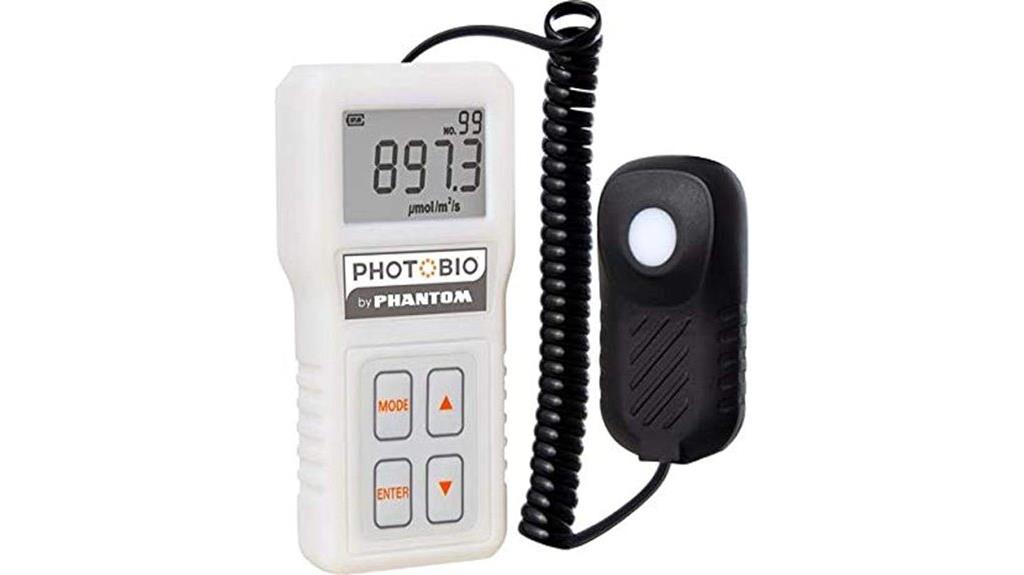
If you’re looking for an accurate and affordable way to measure light intensity for your horticultural setup, the LGBQM2 Advanced Quantum Sensor PAR Meter stands out as an excellent choice. It measures Photosynthetically Active Radiation (PAR) from 400 to 700nm, helping you optimize your lighting for better crop yields. Compatible with LED fixtures, HPS, DE grow lights, and traditional indoor lights, it’s versatile and easy to use. The handheld unit with a remote sensor stores up to 99 measurements, allowing precise adjustments of light height and dimmer settings. Its reliability and straightforward operation make it ideal for growers aiming for consistent, high-quality results.
Best For: indoor horticulturists and growers seeking an accurate, reliable, and affordable light measurement tool to optimize crop yields.
Pros:
- Provides precise measurement of Photosynthetically Active Radiation (PAR) from 400 to 700nm.
- Compatible with a wide range of lighting systems including LED, HPS, and DE grow lights.
- Stores up to 99 measurements for detailed analysis and adjustment during growth cycles.
Cons:
- May require initial familiarity with light measurement procedures for optimal use.
- Battery life depends on usage, potentially requiring frequent replacements or recharging.
- Slightly larger size may be less convenient for very tight spaces or portability needs.
Quantum PAR Meter for LED Grow Lights
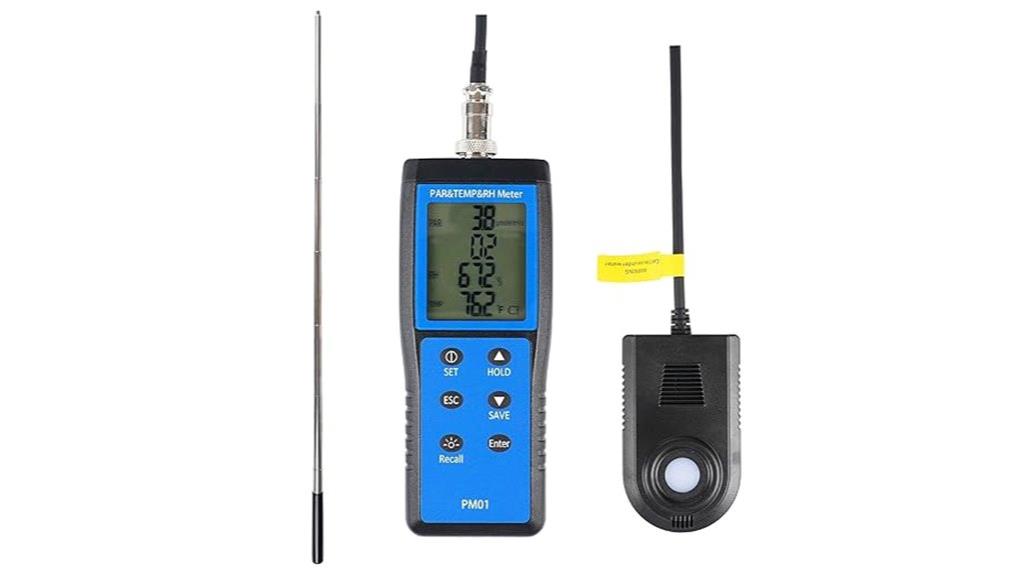
For growers who need precise and reliable measurements of their LED grow lights, the Quantum PAR Meter stands out with its high measurement range and accuracy from 400 to 700nm. It can measure PAR flux up to 3999μmol/m²/sec, ensuring detailed readings of light intensity. The device features a large LCD screen with backlight, making data easy to read, along with calibration options for accuracy. Its sensor, connected via a 60-inch cable, is mounted on a 36-inch telescopic wand, providing flexible testing at different angles and heights. With data logging for up to 99 measurements and additional temperature and humidity displays, it’s a versatile tool for any grow environment.
Best For: professional and hobbyist growers seeking precise, reliable measurement of LED grow light intensity and environmental conditions for optimal plant growth.
Pros:
- High measurement range up to 3999μmol/m²/sec for detailed light intensity readings
- Large LCD display with backlight and calibration features for easy data viewing and accuracy
- Flexible testing with a telescopic wand and sensor mounted via tripod screw for versatile positioning
Cons:
- Sensor cable is not waterproof, requiring careful handling in wet environments
- Relatively large size may limit portability in very tight spaces
- Calibration process may require additional tools or knowledge for optimal accuracy
Portable Par Meter for LED Grow Lights
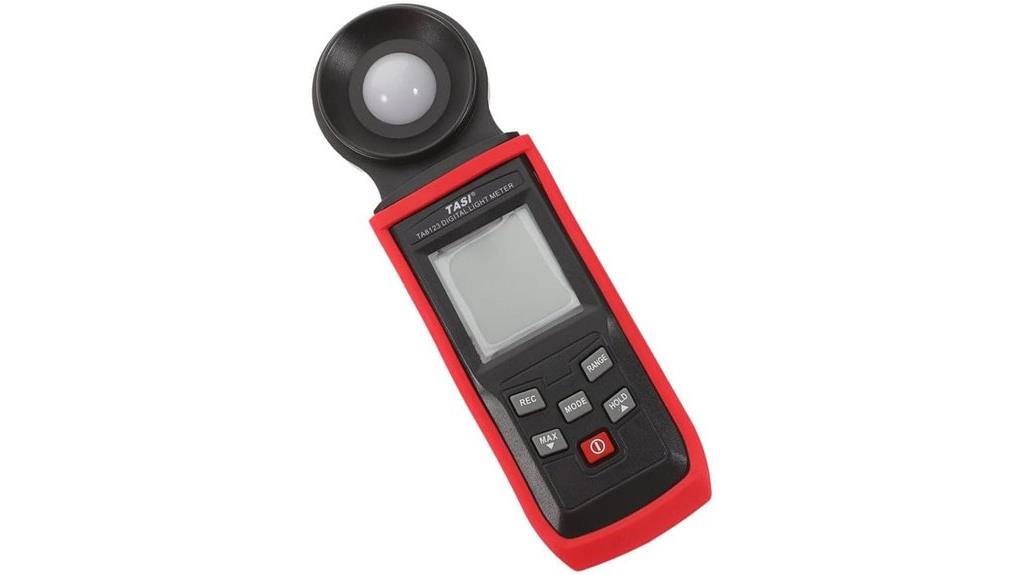
When precision and ease of use matter most, the Portable Par Meter for LED Grow Lights stands out as an ideal choice. Manufactured by HYANG and first available in June 2025, this lightweight device is perfect for recording and monitoring light levels in horticultural setups. Its portability allows me to quickly measure light intensity anywhere in my grow space, ensuring plants receive excellent lighting. With simple operation and accurate readings, it helps me make informed adjustments effortlessly. Whether I’m in the store or in my grow room, I can easily check light levels without hassle, making it a reliable tool for any grower.
Best For: hobbyist and professional growers seeking an easy-to-use, portable light measurement tool to optimize LED grow light performance.
Pros:
- Compact and lightweight, making it highly portable for use anywhere in the grow space
- Simple operation with accurate readings to facilitate quick adjustments
- Manufactured by HYANG, a reputable brand ensuring reliability and quality
Cons:
- First available in June 2025, so long-term user reviews may be limited
- Limited to light measurement; does not include additional horticultural tools
- Availability might vary online and offline, potentially affecting immediate access
PAR Meter for LED Grow Lights with Data Logging and Calibration
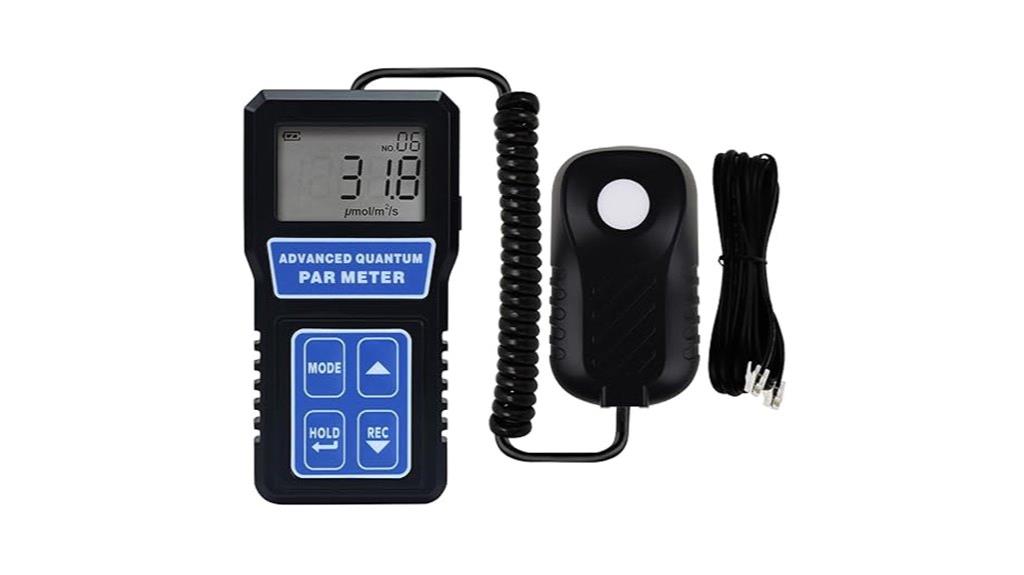
A PAR meter with data logging and calibration is an essential tool for serious growers aiming to optimize their lighting conditions. It measures Photosynthetically Active Radiation within 400-700nm and up to 3999 μmol/m²/sec, providing reliable, accurate readings with ±1 μmol/m²/sec precision. The built-in 100-group data logging feature lets me record and analyze measurements easily, helping improve light setups over time. Its flexible connectivity includes a coiled cable for mobility and a longer straight cable for mounting. With a user-friendly LCD display and optional tripod mount, it’s simple to operate and versatile enough for indoor, outdoor, or greenhouse use, making precise light management straightforward.
Best For: serious indoor growers, horticulturists, and greenhouse operators seeking precise, reliable PAR measurements with data logging capabilities to optimize plant growth conditions.
Pros:
- Highly accurate measurement within 400-700nm and up to 3999 μmol/m²/sec, with ±1 μmol/m²/sec precision
- Built-in 100-group data logging for easy measurement review and analysis
- Flexible connectivity options including coiled and straight cables, plus tripod mounting for versatile use
Cons:
- May require calibration over time to maintain peak accuracy
- The device’s size and features could be complex for casual or beginner growers
- Limited to specific wavelength and measurement range, not suitable for non-LED lighting sources
BTMETER BT-881E Light Meter
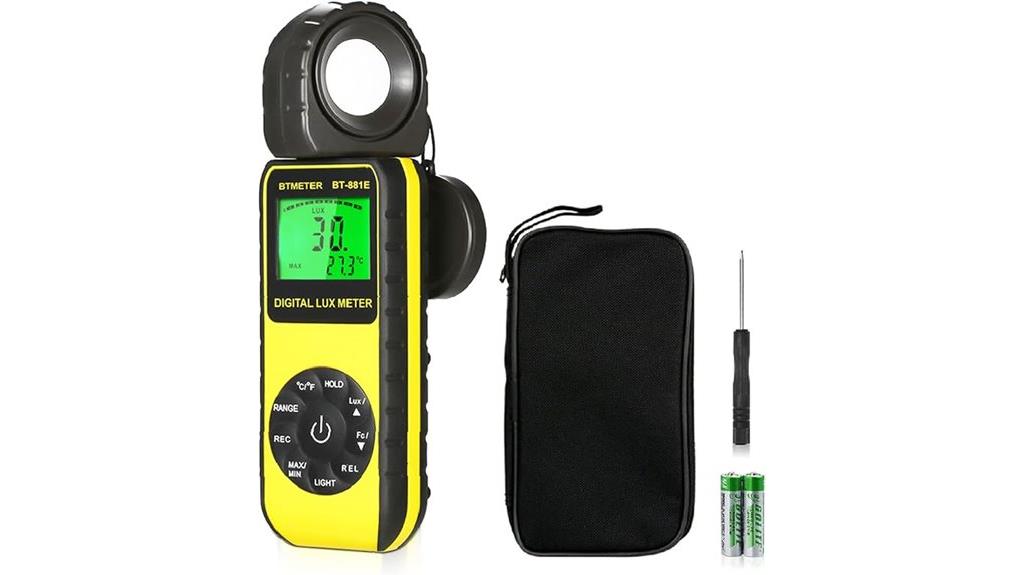
The BTMETER BT-881E Light Meter stands out with its 270º rotatable sensor, allowing me to measure light angles from different directions without repositioning the device. Its wide measurement range from 0.01 to 300,000 Lux makes it versatile for various environments, from indoor gardens to outdoor settings. The device offers high accuracy with ±4% to ±5% readings and responds quickly, providing 2-3 measurements per second. Its simple design and ability to record up to 33 readings make it easy to compare light conditions over time. Overall, it’s an accessible, precise tool perfect for anyone needing reliable light measurements in multiple applications.
Best For: DIY enthusiasts, plant growers, and professionals needing precise, versatile light measurement in various environments.
Pros:
- Rotatable sensor allows measurement from different angles without repositioning the device
- Wide measurement range from 0.01 to 300,000 Lux for diverse lighting conditions
- Fast response time with 2-3 measurements per second for quick readings
Cons:
- Slightly higher cost compared to basic light meters
- Bulkier design may be less convenient for tight spaces
- Requires calibration for optimal accuracy over time
PAR Meter for LED Grow Lights with Bluetooth Connectivity
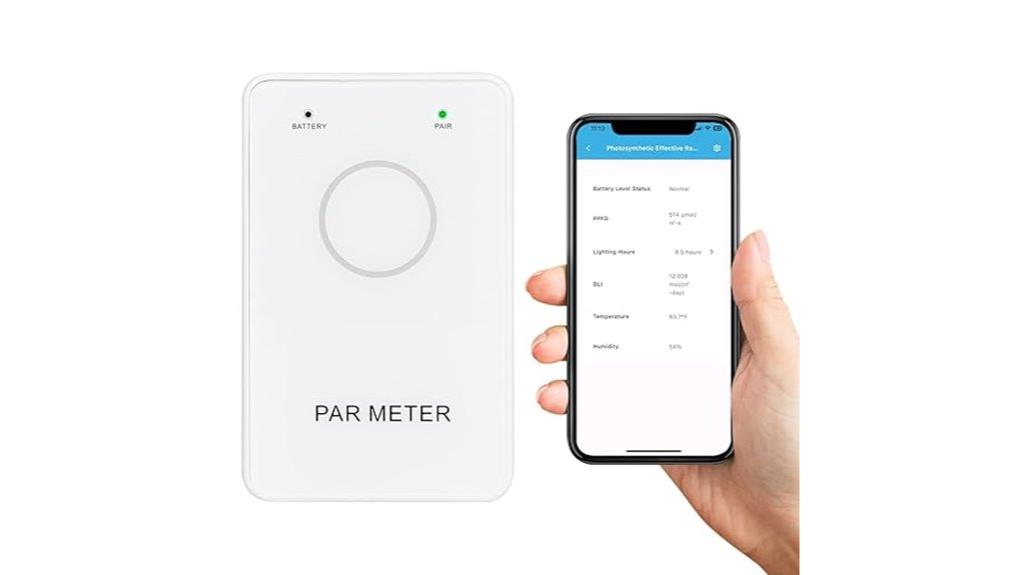
For growers seeking precise, real-time data on their LED grow lights, a PAR meter with Bluetooth connectivity stands out as an essential tool. It accurately measures the light spectrum (400-700nm) used in photosynthesis, helping you maximize your lighting plans. The high-precision PPFD sensor provides real-time PPFD data and calculates DLI, supporting healthier plant growth. Plus, Bluetooth pairing with the Genilife app allows easy monitoring of light intensity, temperature, and humidity from your device. Its durable, flame-retardant design, rechargeable battery, and user-friendly indicators make it suitable for both beginners and professionals. This versatility ensures your plants receive the ideal light environment across various cultivation setups.
Best For: indoor growers, horticulturists, and professional cultivators seeking precise, real-time light measurement and environmental data to optimize plant growth conditions.
Pros:
- Provides accurate PPFD and DLI measurements for optimal lighting strategies
- Bluetooth connectivity with the Genilife app allows easy real-time monitoring of light, temperature, and humidity
- Durable, flame-retardant design with rechargeable battery ensures long-term, safe use
Cons:
- May require familiarity with app setup and data interpretation for new users
- Limited to measuring light in the 400-700nm spectrum; does not cover other light spectrums
- Dependence on Bluetooth connection could be affected by interference or range limitations
Par Meter High Precision PPFD Meter for LED Grow Lights

If you’re serious about optimizing your grow lights, the Par Meter High Precision PPFD Meter stands out as an excellent choice. It measures PPFD up to 4000μmol/m²/sec within the 400-700nm range, giving you precise light intensity data for your plants. The adjustable distance feature helps you fine-tune light levels, and the large LCD makes readings easy to see. With data logging for up to 100 measurements, calibration, and versatile mounting options, it’s suitable for indoor, outdoor, and greenhouse use. Lightweight and portable, this meter reliably provides accurate results, helping you optimize your grow environment efficiently and cost-effectively.
Best For: indoor gardeners, hobbyists, and professional growers seeking precise, reliable light measurement for optimizing plant growth conditions.
Pros:
- High precision measurement of PPFD up to 4000μmol/m²/sec within the 400-700nm range for accurate light assessment.
- User-friendly with a large LCD display, quick calibration, and data logging capabilities for easy monitoring.
- Versatile with adjustable distance, multiple cables, tripod mount, and suitability for indoor, outdoor, and greenhouse environments.
Cons:
- No clear information about international certifications or calibration standards.
- The LCD screen could be brighter for better visibility in direct sunlight.
- Exporting data may be limited, requiring manual review rather than direct data transfer.
SpotOn Quantum PAR Meter for Grow Light Testing
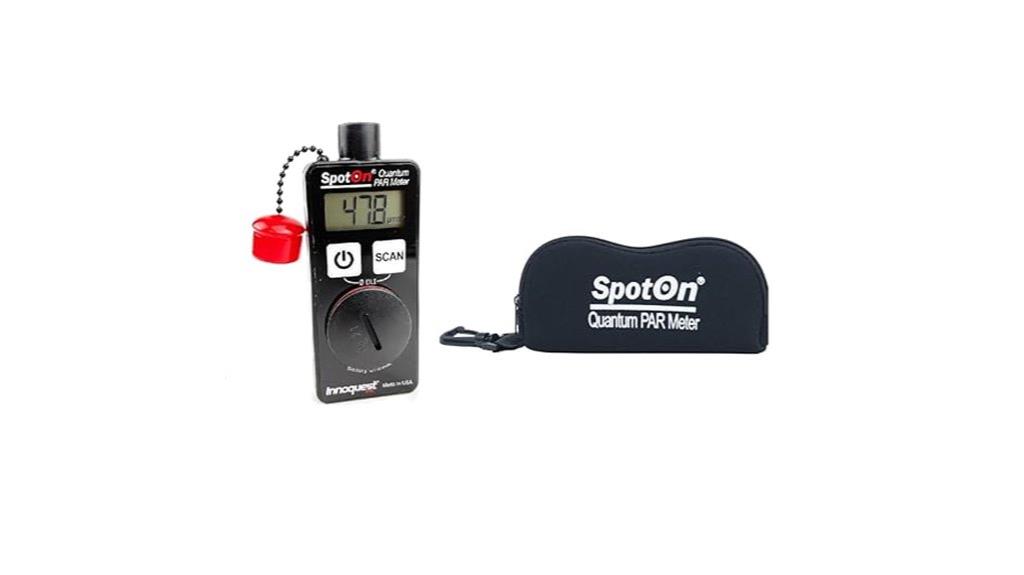
Engineered with NIST-traceable calibration, the SpotOn Quantum PAR Meter offers professional-grade accuracy, making it ideal for growers demanding precise light measurements. It achieves ±5% precision in measuring Photosynthetically Active Radiation (PAR) and light intensity, ensuring reliable data to optimize plant growth. With three modes—Spot, Scan, and DLI—it covers immediate readings, area averaging, and daily light accumulation. Its IP-65 water resistance and impact-resistant design make it durable in wet or harsh environments. Plus, its versatile accessories, including a tripod mount and protective case, allow flexible setup in greenhouses, outdoor spaces, or aquariums, supporting accurate, consistent light measurement everywhere.
Best For: professional growers, horticulturists, and greenhouse operators seeking precise, reliable light measurement to optimize plant health and growth.
Pros:
- NIST-traceable calibration ensures high accuracy and reliable data.
- Multiple measurement modes (Spot, Scan, DLI) provide versatile functionality for various needs.
- Durable IP-65 water resistance and impact-resistant design suitable for tough environments.
Cons:
- May be more expensive than basic light meters, potentially limiting accessibility for casual users.
- Requires familiarity with light measurement concepts to fully utilize all features.
- Battery life could be limited with frequent use in high-demand settings.
Digital Illuminance Light Meter (Luxmeter for Indoor/Outdoor Lighting)

The Digital Illuminance Light Meter (Luxmeter) stands out because of its high measurement capacity, reaching up to 200,000Lux, making it perfect for accurately evaluating light levels in both indoor and outdoor grow environments. Its large screen display, automatic range conversion, and quick response time ensure easy and precise measurements. Whether you’re monitoring brightness for plant growth, photography, or lighting setup, this device supports LUX and FC units for versatile use. It also offers handy features like MAX/MIN recording, data hold, backlight, and auto power-off. Compact and user-friendly, it’s an essential tool for anyone needing reliable light measurement.
Best For: hobbyists, professionals, and facility managers needing precise indoor and outdoor light measurement for plant growth, photography, or lighting setup.
Pros:
- High measurement capacity up to 200,000Lux for versatile indoor/outdoor use
- Large screen display with auto range and quick response time for easy readings
- Features like MAX/MIN recording, data hold, backlight, and auto power-off for convenience
Cons:
- May be more complex for casual users unfamiliar with light measurement tools
- Requires battery maintenance, especially with frequent use of backlight and auto power-off features
- Limited to light measurement; does not include other environmental sensors
Factors to Consider When Choosing a PAR Meter for Grow Lights

When selecting a PAR meter, I focus on measurement range and precision to guarantee accurate readings across my grow space. I also consider spectrum compatibility standards and ease of data logging to make setup and monitoring straightforward. Finally, portability, design, and suitability for different light types help me choose a meter that fits my specific grow environment.
Measurement Range Precision
Choosing a PAR meter with the right measurement range and precision is crucial for accurate readings in your grow environment. Ideally, your meter should cover light intensities from 0 to at least 2000 μmol/m²/sec for most indoor setups. For high-intensity grow lights, look for a device that measures up to 4000 μmol/m²/sec or more to avoid saturation and ensure reliable data. Precision is equally important; a meter with ±3% or better accuracy ensures your readings reflect actual light levels closely. Consistent accuracy across the entire range is essential, so verify that the device maintains its precision at both low and high light intensities. Additionally, calibration options help keep measurements reliable over time and different light sources.
Spectrum Compatibility Standards
To verify your PAR meter provides accurate measurements across different grow lights, it’s important to confirm that its spectral range covers the full photosynthetically active spectrum of 400-700nm. A reliable device should comply with industry standards like IEC or ISO to guarantee spectral accuracy and calibration consistency. It’s also helpful if the meter can measure specific wavelengths relevant to your growth stage, such as blue (400-500nm), red (600-700nm), and UVA (320-400nm) if needed. Compatibility with various light types, including LED, HPS, and full-spectrum grow lights, ensures versatile use. Additionally, some meters provide separate readings for different spectral components, giving you better insight into light quality and spectrum balance for ideal plant growth.
Ease of Data Logging
Efficient data logging is vital for accurately monitoring grow light performance over time, and a good PAR meter should make this process straightforward. Look for devices that can store and retrieve multiple measurements—ideally supporting at least 100 data points—to facilitate thorough analysis. Features like automatic or manual data logging at set intervals help track light fluctuations throughout different growth stages. Easy export options, such as USB, Bluetooth, or app integration, are essential for detailed data review and record-keeping. An intuitive interface and clear display allow quick measurements without complex setups. Additionally, a PAR meter that timestamps each reading ensures precise tracking of light conditions over time, helping optimize your grow environment efficiently.
Portability and Design
Portability and sleek design are essential when selecting a PAR meter for grow lights, especially if you need to move between different grow areas or measure in tight spaces. A lightweight device, usually under 1.5 pounds, makes handling and transport effortless. Many models feature ergonomic shapes, integrated handles, or straps that allow for comfortable, one-handed operation. Detachable or extendable sensors, like telescopic wands or long cables, help reach hard-to-access spots without repositioning the whole unit. Battery-powered units with rechargeable options boost convenience by removing the need for constant power sources during field measurements. durable materials like ABS plastic or aluminum ensure the device remains lightweight while offering durability, making it easier to carry, store, and use across diverse environments.
Spectrum and Light Types
Choosing the right PAR meter involves understanding the specific light spectra it can measure, as different models are designed to detect various wavelengths. Some meters focus on the core photosynthetically active radiation range, from 400 to 700 nm, which is vital for plant growth. Others can measure separate spectral components, like red versus blue light, offering detailed insights into light quality. Including UVA and IR measurements provides a more complete view of the light’s effects beyond basic photosynthesis. The spectral sensitivity and measurement range directly impact how accurately a meter can assess your grow lights. By selecting a PAR meter that matches your specific light spectrum needs, you guarantee precise readings that help optimize your grow environment and promote healthy plant development.
Calibration and Accuracy
Accurate measurements depend heavily on a PAR meter’s calibration and overall precision, so it’s vital to verify these features before making a purchase. Look for devices that offer measurement accuracy within ±5% or better to guarantee reliable monitoring of your grow lights. Check if the meter includes calibration features or has been factory calibrated, which helps maintain consistent and precise readings over time. A NIST-traceable calibration certificate adds confidence that the device aligns with recognized national standards. Prioritize meters with high spectral accuracy within the 400-700nm range, ideally with a tolerance of ±10nm, to accurately capture the photosynthetically active wavelengths. Regular calibration following the manufacturer’s instructions and periodic recalibration are essential to account for sensor drift and uphold measurement accuracy.
Frequently Asked Questions
How Does Sensor Calibration Impact Measurement Accuracy?
Sensor calibration directly impacts measurement accuracy because it guarantees the PAR meter provides correct readings. When I calibrate my sensor regularly, I trust that the data reflects real light conditions, helping me optimize plant growth. Without proper calibration, measurements can be off, leading to under- or overestimating light levels. I always calibrate my sensor before use to maintain precise, reliable readings and achieve the best grow results.
Can PAR Meters Measure Different Light Spectra Simultaneously?
Did you know that some advanced PAR meters can measure multiple spectra at once? Yes, they can! I’ve found that many models now feature multi-channel sensors, allowing simultaneous readings of different light spectra like blue, red, and far-red. This capability helps growers optimize lighting conditions more precisely, ensuring plants get the right light for healthy growth. So, if you’re serious about plant health, investing in a multi-spectrum PAR meter is a smart move.
What Is the Typical Lifespan of PAR Meter Sensors?
The typical lifespan of PAR meter sensors usually ranges from 3 to 5 years, depending on usage and maintenance. I’ve found that regular calibration and careful handling can prolong their accuracy and longevity. If you use your meter frequently or in harsh conditions, expect to replace sensors sooner. Keeping sensors clean and stored properly helps ensure they stay precise and last as long as possible.
Are There Portable Options Suitable for Field Use?
Did you know portable PAR meters are a game-changer for outdoor growers? Yes, there are several options perfect for field use. I recommend models with handheld designs, waterproof features, and long-lasting batteries. These tools are lightweight and easy to carry, making spot checks quick and efficient. Whether you’re monitoring sunlight for your plants or managing light levels in different locations, portable meters give you accurate readings on the go.
How Do Environmental Conditions Affect PAR Meter Readings?
Environmental conditions can greatly impact my PAR meter readings. For example, high humidity or dust can interfere with sensor accuracy, while extreme temperatures may cause fluctuations. I always make sure to calibrate my meter in the same environment where I’ll be taking measurements. Keeping sensors clean and avoiding rapid temperature changes helps ensure I get the most accurate readings, no matter where I’m working.
Conclusion
Choosing the right PAR meter can seem overwhelming, but it’s like balancing precision with simplicity. While advanced models offer detailed insights, sometimes straightforward tools reveal the essentials. In this dance between complexity and ease, I find that understanding your specific needs guides the best choice. Ultimately, the right meter illuminates your grow space clearly, reminding us that measuring light isn’t just about numbers—it’s about nurturing growth with clarity amidst the complexity.
